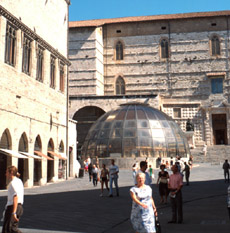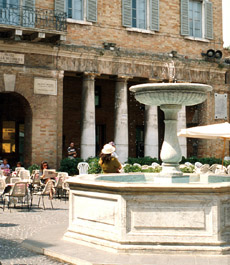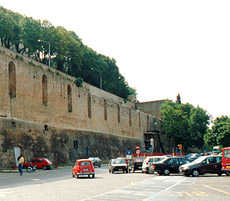index
Are the hill towns real?
click on images for full-size:
Workers in Montepulciano
A fountain on Perugia's main square, covered with a dome to protect it from further deterioration
A fountain in Urbino, amid daily life
Modern parking lot along an old wall in Urbino
So are the hill towns still real places? But, what would it mean for them not to be real? The people in the towns are real in their scramble to survive. Would a critic claim that while their lives are real, the setting is not? What would have to be preserved to make the impatient critic judge the towns to be real? For true reality, must we require the citizens to do hand labor in the fields? Would the towns be most real if they were isolated and unnoticed, out of the flow? No, to be more real is to be in today's complex world. Or are we trying to reassure ourselves with some image of people going about their daily lives with no concern for the eye of the uprooted Other, and no need to fish for sustenance in our wider economic streams? What function does a picture of such "real" places play in our own psychic or social economy? Maybe what we want is for the towns to have a unified and character different from our everyday. Imagine that the towns were indeed fully isolated, turned in on themselves, unique, with no visible connections to our busy world, and no tourists from outside looking on. How would they then function for us outsiders? Imagine that the isolated town is full of hidden video cameras, and that unbeknownst to the citizens, we can observe everything they do, as in the film The Truman Show. Would such universal voyeurism be the truest tourism? No, because it would lack that contact sought by the tourist, who leaves home to touch and be brought inside another world, not just to play the voyeur at another TV set. Tourists want to touch the real life of the place. But then begins the dialectic MacCannell analyzes. The inside, the backstage, the real life, becomes another performance. You can never reach the final back room. (MacCannell 1989) However, MacCannell's description of this dialectic is misleading. He presupposes a closed notion of the back spaces and activities, so in some ways he perpetuates the duality he should be criticizing.



